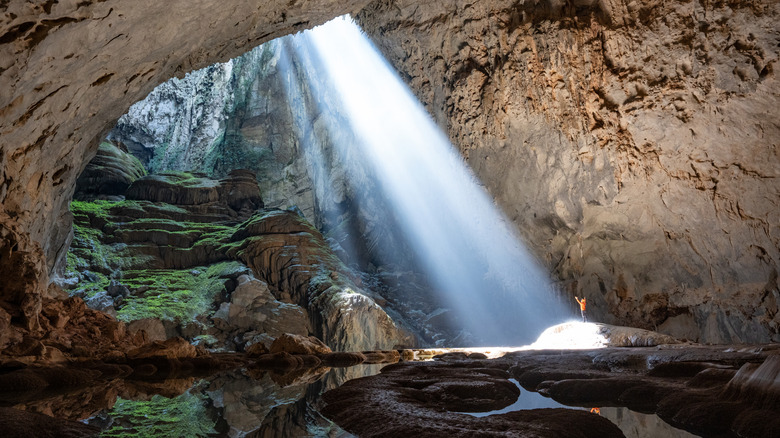The Discovery of Son Doong Cave
Imagine the surprise of a young lumberjack named Ho Khanh, who hailed from Phong Nha, a quiet town in Vietnam. In 1990, during a storm, he stumbled upon an eerie sight: enormous columns of fog rising from the ground, as if the earth itself was exhaling in anger. This moment marked the beginning of the fascinating story of Son Doong Cave. Khanh described this mysterious phenomenon to a British-Vietnamese caving expedition that arrived in Phong Nha seventeen years later. Although he couldn’t initially locate the site, he eventually found it on his own and guided the team to the entrance in 2009. By 2013, the Guinness World Records recognized Son Doong as the largest natural cave in the world.
A Spectacular Natural Wonder
Son Doong is part of the Phong Nha Ke Bang National Park, a breathtaking cave system located in central Vietnam. This area is a UNESCO World Heritage Site and one of Asia’s most remarkable, lesser-known attractions. The cave remains largely unexplored, suggesting it could be even larger than currently known. As of now, Son Doong stretches almost 6 miles in length, with some sections reaching up to 650 feet high and 525 feet wide. One of its most impressive passages, Hope and Vision, is large enough for a Boeing 747 to fly through. Since 2013, visitors have been able to explore this otherworldly landscape through a four-day trek offered by Oxalis Adventures, the only authorized tour company for these expeditions, at a cost of $3,000 per person.
Exploring the Depths of Son Doong
During this once-in-a-lifetime journey, travelers will cross several underground rivers. The name “Son Doong” translates to “mountain river cave,” a fitting title given the cool rivers that flow through its limestone formations. Over millions of years, the Khe Ry and Rao Thuong rivers have carved out the passages you’ll visit, creating a space so vast that a city block of skyscrapers could fit inside. Due to its size and the presence of rivers, clouds have formed within the cave, resulting in its own unique climate and weather systems.
On the second and third days of the expedition, you’ll camp at two stunning dolines, known as Watch Out for Dinosaurs and Garden of Edam. Dolines are natural skylights formed when parts of a cave’s ceiling collapse, offering excellent opportunities for photography. Between 11 a.m. and 1 p.m., at the first doline, you’ll witness sunlight streaming into the passage. You might not see any dinosaurs, but you’ll pass the Hope and Vision stalagmite, speculated to be the tallest in the world at 262 feet high, and the photogenic, mushroom-shaped Hand of Dog structure.
At the second doline, you’ll discover a unique ecosystem that has remained untouched for millions of years, filled with lush vegetation. Here, you can spot mosses, ferns, various trees, begonias, and other plant species, as well as occasional monkeys, birds, and snakes. This primeval jungle resembles a scene from “Jumanji.” On your final day, you’ll face the challenge of ascending the Great Wall of Vietnam, a 295-foot calcite flowstone overlooking an emerald-green lake. This ascent requires technical caving equipment, and after climbing, you’ll reach the cave’s exit.
Preparing for Your Expedition
To begin your adventure, you’ll meet your group in Dong Hoi, which is accessible via bus, train, or plane. From Hanoi or Ho Chi Minh City, you can take a domestic flight to Dong Hoi Airport. If you’re coming from Da Nang, sleeper buses and trains are available. For first-time visitors, it’s essential to understand key details about traveling in Vietnam.
You might wonder why the trip costs so much, especially since Vietnam is generally an affordable travel destination. However, the $3,000 fee includes taxes, national park fees, transportation, safety gear, accommodations, food, and more. Each expedition also includes porters, chefs, guides, and experienced staff to ensure a safe and memorable experience.
Son Doong can only be visited from the end of January to the end of August due to the dangerous weather conditions outside this period. It’s crucial to book well in advance, as tours for 2026 are already sold out, and 2027 is now open for reservations. Each tour accommodates up to 10 participants, with a maximum of 1,000 visitors annually. Oxalis welcomes adventurers aged 18 to 70, but participants must be in good physical condition to handle the challenging terrain and technical aspects of the trek. This experience involves wading through knee-deep rivers, scrambling over boulders, rope-climbing using ladders, and crossing sandbanks, with elevation changes ranging from 500 to 2,600 feet.
Ready to uncover more hidden treasures and expert travel tips? Subscribe to our free newsletter for access to the world’s best-kept travel secrets.



